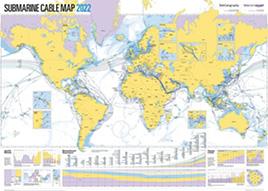11 May 2022

Africa gained new undersea cables with a combined construction cost of U$12bn from 2016- 2021, with the continent continuing to benefit from new investment for years to come, according to a report.
TeleGeography, a global telecommunications market research and consulting firm, has published its new Submarine Cable Map and Africa Telecom Map for 2022 and projects that subsea cable spending will strengthen as hyperscalers shift their position from generating demand to generating supply.
“Our research has shown constant advancement year-on-year, as pressure for bandwidth continues to grow,” says Alan Mauldin, research director at TeleGeography. “Content providers’ international bandwidth growth has accelerated as of late. Companies like Meta, Microsoft, and Netflix have millions of users who are driving up demand every day.”
TeleGeography’s regional Africa Telecom Map highlights 71 cable systems connected to Africa that are currently active or under construction. The map covers used bandwidth, internet capacity, pricing trends, and content provider investment in both cable systems and cloud data centres. Broadband and mobile penetration rates for each of the 54 countries in Africa are also included in the main projection.
Notable cables featured in the new design include the African submarine cable consortium project 2Africa, which will extend 45,000 kilometres and link 33 countries in Africa, the Middle East, and Europe. This new cable could enter service as soon as 2023. Also included is Google’s private cable Equiano – initially linking Portugal, Nigeria, Namibia, South Africa, Togo and St. Helena, but could expand to many other countries.







